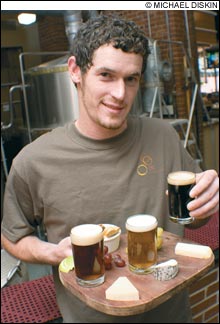Any way you slice it, cheese is growing in popularity at restaurants all over town

Cambridge Brewing Company's Morgan Law
|
Is cheese the new breakthrough trend? When a $12 beer-and cheese pairing becomes a menu staple at Cambridge Brewing Company, it’s clear that cheese-tasting courses have gone mainstream. Pretty amazing, considering that not too many years ago, the idea of ordering a cheese course bespoke a certain affectation, a faintly European snobbery. We Americans ate our cheese straight from cellophane blister packs; we didn’t have time to coddle fragile little bundles wrapped in salt-washed rinds or protected in ash.
According to Morgan Law, bartender/manager at Cambridge Brewing Company, the brewpub has been overwhelmed by demand for its cheese-and-beer plate. “We put it on as a special, working with the cheese mongers at Formaggio [Kitchen],” he says. “But it was so popular we couldn’t take it off the menu. People order it as a dessert, as bar food, or as a course on its own.” The current CBC beer-and-cheese plate features Roncal, a Spanish sheep’s-milk cheese; Pomerol, a cow’s-milk cheese from France; and Monte Enebro, a Spanish goat’s-milk cheese with ash rind. What happened to the neighborhood brewpub where the most exotic thing on the menu was a sweet-potato fry?
Clearly, cheese nerdiness has hit the big time, with interest surprisingly high among a generation of young restaurant-goers who didn’t grow up genuflecting to the image of Julia Child. According to local cheese mongers and restaurant staff, Boston diners are chock full of cheese-y questions. “They want to know where the cheese was farmed, whether it’s organic or biodynamic, and who farmed it,” says Robert Aguilera, general manager of Formaggio Kitchen in Cambridge.
More specifically, reverence for American farmstead cheeses is becoming a new rage across the country. Just as California wines became a serious international competitor, so too are US cheeses gaining national and international respect. Learning about luscious, American-made sheep, goat, and cow cheeses is the new cool thing coast to coast. Several restaurants in Boston — including Harvest, Henrietta’s Table, and Great Bay — are offering cheese plates featuring exclusively American artisanal cheeses. Sure, we still import many fine cheeses from Europe, but most of the cheese we eat in this country is made right at home. And it’s no longer merely chunks of cheddar and slices of Alpine Lace, nor does all American cheese get shipped by the container-load from Wisconsin’s mega-dairies. It’s goat cheese from upstate New York, sheep’s-milk pecorino from Oregon, Brie look-alikes from the Napa Valley. American artisanal cheese is now as chic and as hard to get as any unpasteurized Pont l’Évêque smuggled in from France. One popular cheese Web site, www.curdnerds.com, lists more than 140 American independent, artisanal-cheese makers working in small dairies from Petaluma, California, to Guildhall, Vermont. (For another great cheese site, visit www.forkandbottle.com.)
Just how much cheese do we eat? According to USDA figures, in 2004 Americans consumed an average of 31 pounds of cheese per person, a figure expected to edge up to 34 pounds annually by 2015. (By contrast, US cheese chomping was a scant 18 pounds per capita in 1980. Of course, we still lag behind the French, who in 2004 consumed a hefty 53.9 pounds of cheese per person. And the French trailed behind the Greeks, who whaled through 63.1 pounds per person. That’s a lot of feta on those Greek salads.)
ADVERTISEMENT
 |
Our growing appetite for cheese is reflected on many local menus. More and more Boston-area restaurants at all price levels now consider an artisanal-cheese plate a menu mainstay, available as an appetizer, bar snack, pre-dessert course, or dessert. The list of cheese-friendly zones includes L’Espalier, No. 9 Park, the Elephant Walk, Eastern Standard, Rendezvous, Rialto, Vinalia, UpStairs on the Square, 33, Fireplace, Flora, and Tryst, among others. But eating fancy cheese is something you can also try at home. If you need a primer to boost your curd quotient, Formaggio’s Aguilera is ready to assist. “Never buy a cheese that you can’t taste,” he advises. “Don’t be fooled into buying a cheese that’s already all wrapped and cut, unless you really know the cheese and know how often the cheese store turns its inventory. Never taste less than two cheeses at a time, or you won’t be able to calibrate your palate, because cheeses can differ so much from animal to animal. And, with every new cheese, you have to take three bites. The first bite will overwhelm you, the second will set your palate, and the third bite will deliver the flavor punch.”
Go cheese shopping with an open mind, looking for flavor or consistency rather than for a specific cheese, adds Aguilera. “Knowing that you want something oozy, runny, creamy, smelly, or sharp will help the cheese monger pick cheeses that you might like but wouldn’t have thought to buy. Let’s say you want a sharp cheese. It doesn’t have to be cheddar; you might end up falling in love with a sheep pecorino from Tuscany. Buy cheeses from three different animals — goat, cow, and sheep — with one of them a blue cheese. You’ll get a huge variety in the flavors.” What condiments best complement cheese? “Dried apricots are the number-one palate cleanser,” Aguilera says. “They give you a clean but not citrusy mouth. Second choice is fried, salted Marcona almonds, and the third is honey, from lavender to truffle — any kind of honey will highlight the flavor of almost any cheese.” As for assembling the perfect cheese course, Aguilera suggests the three Cs: “Compare, contrast, and complement.”